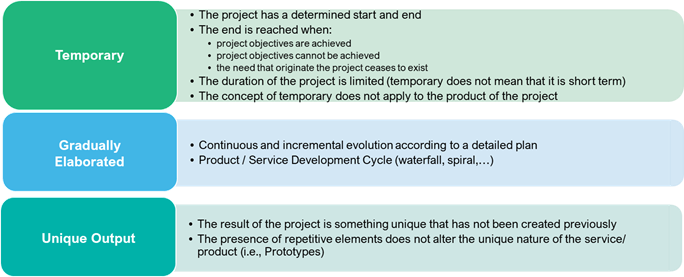PMI defines project management as “the application of knowledge, skills, tools, and techniques to project activities to meet the project requirements.” In other words, the project management purpose is to plan and manage a project to successfully complete its listed goals and deliverables. It involves identifying and managing risks, careful resource management, smart budgeting, and clear communication across multiple teams and stakeholders.
Project management seems to be an easy job, but it is important to keep in mind that many projects fail (yes, that is true!). Do you know why? Let’s find out by checking some PMI statistics:
47% fail to meet their goals due to poor management of requirements.
44% fail due to a lack of alignment between business and project objectives.
37% fail due to a lack of defined project objectives and milestones.
Finally, 27% of projects usually run over budget.
Companies use project management to contribute to these percentages reduction by achieving results in a measured, focused, and predictable way. Project management processes keep complex plans organized and all individuals involved aligned and focused with specific roles and responsibilities.
But what is a Project?
A project is a temporary organizational structure set up to create a unique service or product (output) within certain constraints such as time, cost and quality. The image below explains the main project’s characteristics:

Every project aims to introduce a new service/product or to change an existing one. Achieving the goal is expected to bring benefits to the organization. A project can also be seen as a transformational process, which turns ideas into reality. Projects may be carried out to maintain current business operations, to transform business operations, or to improve the way of working so the organization can be more efficient in the future.
Before moving forward, it is important to distinguish projects from processes.
Projects are temporary and should therefore have a defined start and end. A project should be considered complete when it is determined that its goals and objectives have been accomplished. Once this happens, the project team should be disbanded.
Processes, on the other hand, comprise the ongoing day-to-day activities undertaken by a permanent organization to deliver services or products.
Usually, the project management life cycle is organized into 5 phases: initiating, planning, execution, monitoring & control and closing. The focus of a project shifts from initiating and planning activities in the beginning to executing, monitoring and controlling activities in the middle and acceptance, transitioning and closing activities at the end. The Project Management phases are not events that happen only once, as there are activities that occur at different levels of intervention during the project lifecycle.
How do we manage projects at Wysupp?
Wysupp follows a project management methodology that aims to provide a structured approach, which also combines a flexible way of adapting the way projects are managed, depending on their type and dimension. Therefore, Wysupp applies a Hybrid Project Management approach.
The “hybrid project management approach combines the formal (Waterfall) and Agile methods to create a new project management method. Hybrid employs the thoroughness of Work Breakdown Structure (WBS) with speed and lean benefits of Agile for a new project management method which is both detailed and fast.”
The main goal of a hybrid project management approach is to choose the most suitable methodology for each project phase. For example, it is possible to plan and define requirements with Waterfall, and design, develop, and test with Agile which helps to organize work in a more predictable way.
Wysupp applies this project management methodology to:
Create a project management framework that allows project control in terms of scope, budget, deliverables and main constraints.
Improve communication and information dissemination.
Clarify expectations as soon as possible in the project lifecycle.
Provide guidelines and templates to be used during project implementation.
So, why do we need a Project Manager?
If there is a defined methodology that everyone within a company can follow, why do we need a Project Manager?
The project manager is responsible for maintaining a common methodology within the organization, providing guidelines that help to manage the different projects and, last but not least, establishing norms, methods, processes and practices that should be implemented within an organization.
Project Managers need to understand the project management methodology and must have the technical competencies required to effectively manage the initiation, planning, execution, monitoring and control and closing project´s phases. Moreover, the role requires skills to work effectively with people and within a broader organizational context. These include the contextual and behavioral skills necessary to manage complex projects with diverse teams and stakeholder groups that have pluralistic and conflicting priorities. Therefore, Project Managers also need to understand:
How to communicate, lead, motivate, negotiate, solve problems and deal with issues, conduct meetings and workshops, report project status, among others.
The business context and the general project environment (sociocultural, political, physical).
Organizational policies and standards (security, organizational architecture, audits).
How the end-product or service will be maintained after it is delivered.
In summary, we need a Project Manager to guarantee, among other things:
Leadership: the project manager brings direction and leadership to projects.
Strategy alignment: the project manager ensures that real value will be delivered at the right time.
Focus and Clear Goals: the project manager ensures that a proper project plan is well defined and adapted to change. Moreover, should be able to align expectations by setting up what can be delivered, how much it will cost and when it will be possible to finish it.
Risk Management: the project manager identifies, analyzes and defines responses to risks that may somehow impact the project. Risk management improves the project team’s confidence by proactively managing any potential event that might have a positive or negative impact on project objectives.
Cost reduction: the project manager helps to reduce project costs by improving efficiency, mitigating risks, and optimizing resources. In 2018, according to PMI, 9.9% of every dollar invested was wasted due to poor project performance - that’s $99 million for every $1 billion invested. Even with the added cost of investing in a project manager, organizations stand to gain much more.
A good Project Manager learns from the successes and failures of the past and implements continuous improvement techniques to ensure that projects are carefully planned, directed and aligned with a company’s strategic goals. By doing so, he/she helps to set and achieve key business objectives, increase a team’s productivity and ensure that projects stay within budgets and timelines.
According to PMI “Understanding the importance and value of project management is the keyways to ensure project success. Other than that, with well-defined processes and practices, the chances of project success automatically increase.”
Lea Nogueira Lima
Project Manager at Wysupp
25 October 2021

